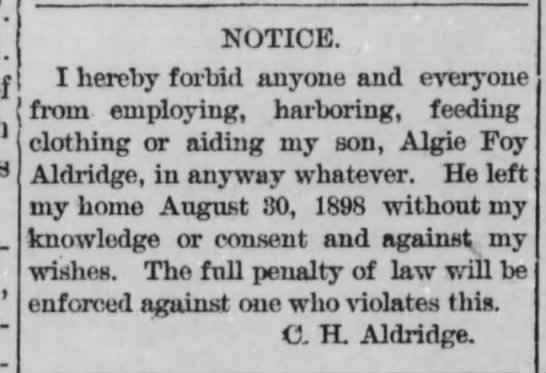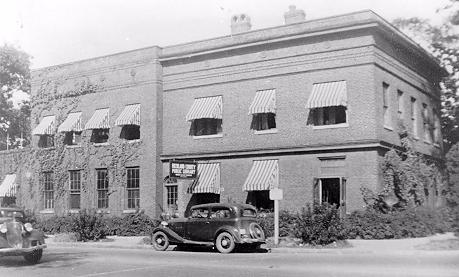
The Enterprise
6 October 1898 • Page 3
Algie Foy Aldridge was the youngest son of Caleb Hampton Aldridge, the eldest son of Henry Garner Aldridge and Priscilla Murray Aldridge. When "Hamp", as he was better known, posted this ad in the Stanly County, North Carolina newspaper "The Enterprise", Algie Foy would have been 17 years old. He was born on August 4, 1881 and must have inherited that "mean streak" that ran through the Murray line and into the Aldridge line through his grandmother Priscilla. While some Murray descendants did not seem to inherit this unlucky trait, several in any given generation seem to have suffered from it.
Algie's discontent seemed to show at an early age.
I wondered about his name, "Algie Foy", where did that moniker come from. I think Algie might have been short for "Algernon" and Foy just a trend, as I've seen many "Roy's" and even "Hoy", "Loy", "Doy",and "Coy" being popular names and middle names, for males of his generation. But he was not named for any apparent ancestor. His mother was Elizabeth "Bettie" Floyd McSwain Aldridge, who had first married John Calloway McSwain, who perished in the Civil War. Hamp Aldridge was her brother-in-law and when her sister Sophia Floyd Aldridge passed away after bearing Hamp only one child, George Gilliam Aldridge, Bettie and Hamp married. Bettie brought a child of her own, Martha Ella McSwain, who would have a daughter by her step-father at the age of 18, and the family would survive this atrocity and remain intact.
That is how powerful a man Hamp Aldridge was in the community. He had a tendency to do whatever he pleased and get by with it. Hamp carried the Murray mean streak. It may have been this trait that drove his son away from him at the age of 17, and Hamp wanted to make sure the boy had no support in his quest for freedom.
Algie must have returned home the prodigal son because he turns up in the 1900 census in his father's house, although the census taker made meatloaf with it.
| Name: | Alpha Auldredz [Alpha Aldridge] [Alpha Auldredg] | ||||||||||||||||||
|---|---|---|---|---|---|---|---|---|---|---|---|---|---|---|---|---|---|---|---|
| Age: | 18 | ||||||||||||||||||
| Birth Date: | Aug 1880 | ||||||||||||||||||
| Birthplace: | North Carolina | ||||||||||||||||||
| Home in 1900: | Tyson, Stanly, North Carolina | ||||||||||||||||||
| Race: | White | ||||||||||||||||||
| Gender: | Male | ||||||||||||||||||
| Relation to Head of House: | Son | ||||||||||||||||||
| Marital Status: | Single | ||||||||||||||||||
| Father's Name: | Hamp Auldredz | ||||||||||||||||||
| Father's Birthplace: | North Carolina | ||||||||||||||||||
| Mother's name: | Elisabeth Auldredz | ||||||||||||||||||
| Mother's Birthplace: | North Carolina | ||||||||||||||||||
| Occupation: | View on Image | ||||||||||||||||||
| Neighbors: | View others on page | ||||||||||||||||||
| Household Members: |
| ||||||||||||||||||
Algie did not remain in his father's home long, however. He removed to Cabarrus County, and probably began his lifelong career in the textile industry working in the Cannon mills or similar ones located throughout Concord and nearby Kannapolis. There he met his wife and future victim, Cora Murphy.
| Cora Murphy
North Carolina, Marriages, 1759-1979
|
|
|
And I did not mean "victim" in any sense but literally.
Algie and Cora, his Irish bride, show up in the City Directory of Columbia, South Carolina in 1909. He is a Mill Operator.
 |
| Algie Foy's Draft Papers describe him as being of Medium height and build with blue eyes and gray hair. |
Algie's wife Cora was the daughter of James A. and Margaret A. Porter Murphy. Her father was born in Ireland and her mother in North Carolina. Her father, James Alexander Murphy was one of those grand old patriarchs of the 19th century who outlived several wives and was fathering children well into his sunset years. Born in 1816, he died in 1906 in Columbia, Richland County, South Carolina. In the 1910 census, Algie and Cora are shown living in the household of her widowed mother and a number of her siblings, including youngest brother, Emmett.
| Name: | Cora Aldrich | ||||||||||||||
|---|---|---|---|---|---|---|---|---|---|---|---|---|---|---|---|
| Age in 1910: | 28 | ||||||||||||||
| Birth Year: | abt 1882 | ||||||||||||||
| Birthplace: | North Carolina | ||||||||||||||
| Home in 1910: | Columbia Ward 5, Richland, South Carolina | ||||||||||||||
| Race: | White | ||||||||||||||
| Gender: | Female | ||||||||||||||
| Relation to Head of House: | Daughter | ||||||||||||||
| Marital Status: | Married | ||||||||||||||
| Spouse's Name: | Algie Aldrich | ||||||||||||||
| Father's Birthplace: | Ireland | ||||||||||||||
| Mother's name: | Margaret Murphy | ||||||||||||||
| Mother's Birthplace: | North Carolina | ||||||||||||||
| Neighbors: | View others on page | ||||||||||||||
| Household Members: |
|
The Columbia City Directory traces their movements and Algie's career changes through the next decade. Algie's name is seen variously as "Alpha", "Alva", "Alfie", "Ollie", and "Algie". It may have been a derivative of the proper name "Alva", which was used randomly in and around Stanly County where he was born.
In 1909, they had been living at 901 9th Street, which was her parents address.
By 1911, the couple had moved to 209 Assembly Street and Algie was a Motorman for the Railway.
1912 - "Alger F." and Cora Aldridge had moved to 890 Lower Street and he was still employed at the same occupation.
1913 - They had moved to 222 Sumter Street and Algie was back to being a Mill Operator.
 |
| Old Columbia Library at the corner of Washington and Sumter Streets. |
1916 - This time they were living at 1313 Berkeley Avenue, Mill Operator
1918 - Back to Lower Street, but this time at 819 Lower Street and Algie was now an employee of "Swift and Co."
1920 - They were still at 819 Lower Street, after at least 6 moves in a decade, but Algie had changed jobs again and this time was working for the Union News Company.
| A street scene in old Columbia |
| Name: | Cara E Aldridge | ||||||||||
|---|---|---|---|---|---|---|---|---|---|---|---|
| Age: | 37 | ||||||||||
| Birth Year: | abt 1883 | ||||||||||
| Birthplace: | North Carolina | ||||||||||
| Home in 1920: | School District 4, Richland, South Carolina | ||||||||||
| Race: | White | ||||||||||
| Gender: | Female | ||||||||||
| Relation to Head of House: | Wife | ||||||||||
| Marital Status: | Married | ||||||||||
| Spouse's Name: | Algie F Aldridge | ||||||||||
| Father's Birthplace: | Ireland | ||||||||||
| Mother's Birthplace: | North Carolina | ||||||||||
| Able to Read: | Yes | ||||||||||
| Able to Write: | Yes | ||||||||||
| Neighbors: | View others on page | ||||||||||
| Household Members: |
| ||||||||||
The next decade would also show the train of instability.
By 1922, the family had moved to 308 Bull Street and Algie was a News Agent.
On 1923, Algie had again became Mill fodder and moved his family to 709 Green Street, which is now only an Oak tree guarding the end of a dead end road.
709 Greene Street.
Five years later, Algie was now employed as a Jitney Driver and had moved to an apartment building on Park Street, a few blocks over and one block off of the former home on Assembly Street.
Park Street Apartments

By 1930, son Leo has moved out and a teenaged Vermelle is only at home.
| Name: | Algie F Aldridge | ||||||||
|---|---|---|---|---|---|---|---|---|---|
| Gender: | Male | ||||||||
| Birth Year: | abt 1882 | ||||||||
| Birthplace: | North Carolina | ||||||||
| Race: | White | ||||||||
| Home in 1930: | Columbia, Richland, South Carolina | ||||||||
| Map of Home: | View Map | ||||||||
| Marital Status: | Married | ||||||||
| Relation to Head of House: | Head | ||||||||
| Spouse's Name: | Cara Aldridge | ||||||||
| Father's Birthplace: | North Carolina | ||||||||
| Mother's Birthplace: | North Carolina | ||||||||
Occupation:
Education: Military service: Rent/home value: Age at first marriage: Parents' birthplace: | |||||||||
| Neighbors: | View others on page | ||||||||
| Household Members: |
|
In 1934, Algie and Cora are still at the same location on Park Avenue and Algie is still a driver.
| Name: | Algie F Aldridge |
|---|---|
| Gender: | Male |
| Residence Year: | 1934 |
| Street address: | 424 Park |
| Residence Place: | Columbia, South Carolina |
| Occupation: | Driver |
| Spouse: | Cora E Aldridge |
| Publication Title: | Columbia, South Carolina, City Directory, 1934 |


The above article is from the May 19, 1938 edition of The Greensboro Record. The story was reprinted in newspapers far and wide, giving pretty much the same information. North Carolina, South Carolina and even New York newspapers reported the story of the textile worker who openly admitted the murder of his wife after finding a photo of another man in her possession. The readers were shocked. He didn't deny it. He even blamed it on this unnamed other man whom he assumed his wife was interested in. He had been thinking about the murder for three weeks. It was premeditated. The bad Murray blood was running hot in Algie Foy Aldridge.
 |
| Thursday, May 19 1938 edition of the State Times Advocate of Baton Rouge, Louisiana. |
So what happened next?
Cora did not die immediately, but passed soon after arriving to the hospital.
Her death certificate explains her horrific cause of death with the words "Hacked", "Axe" and "Homocide". In the end she bled to death?
But what of Algie? Did he get his day in court? Did the papers print anything of that?
The amazing answer is "No".
On December 6, 1939, a year and a half after he murdered his wife Cora on May 18, 1938, Algie Foy Aldridge died of a cerebral hemorrhage. He was treated at the South Carolina State Hospital and the doctor notated that he had been under his care since June 8, 1938. Algie had spent about 2 weeks in jail before being declared insane and mentally incapable of standing trial. He spent the remaining year and a half of his life in psychiatric care. Was the cerebral hemorrhage a sign of a brain disorder that may have attributed to his lack of judgement and irrational behavior in the murder of his wife? Possibly. This cause of death shows up in many of the descendants of the Aldridge and Murray families. Is it hereditary? Probably.
There were many stories that began and/or ended in the rolling hills of the Tyson community of Stanly County. Algie Foy Aldridge's story was just one of them.
| Name: |
| |
| Source: |
| |
| Date: |
| |
| Place: |
|






